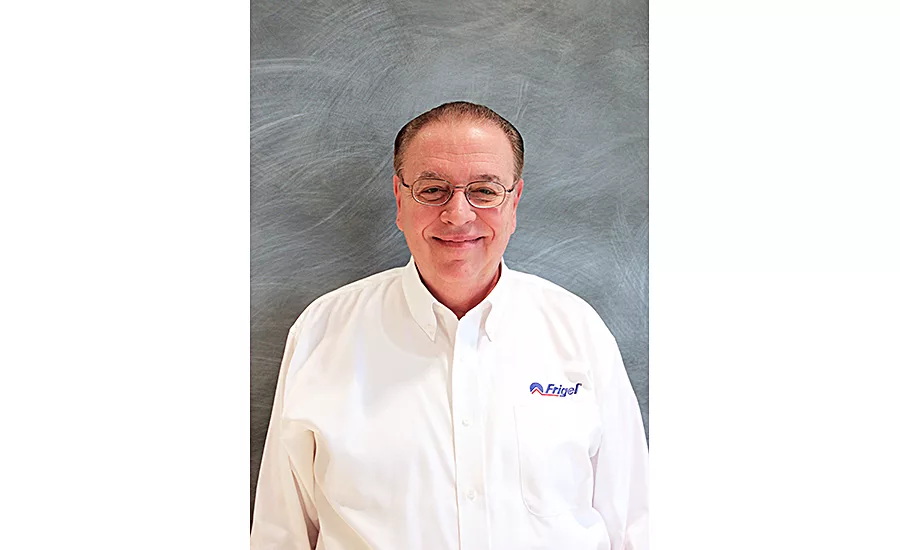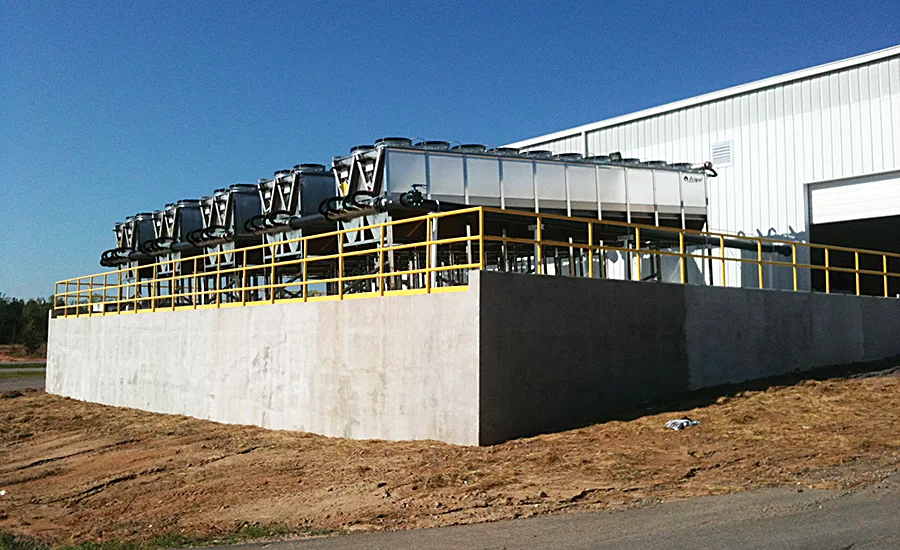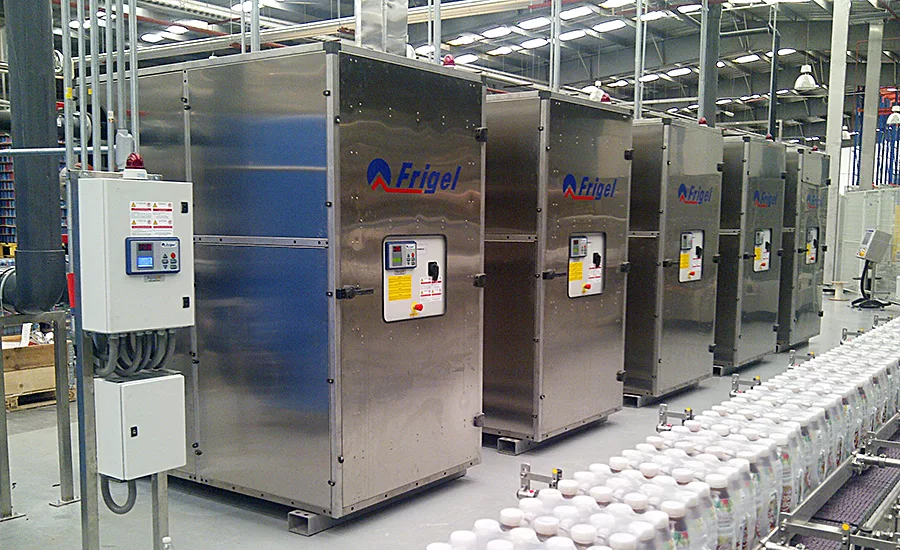Engineering R&D
Think cooling from an intelligent system standpoint

Al Fosco is a regional manager for Frigel. He has a master’s degree in heat transfer and fluid dynamics from the University of Illinois.

Adiabatic fluid coolers do not use evaporation of the process water, as cooling towers do; they use ambient air to cool the fluid inside finned-tube heat exchange coils. Source: Frigel.

Adiabatic cooling can be used locally on production lines. Source: Frigel.
Cooling systems designed and operating without regard for an entire facility’s different cooling needs can be big energy wasters. For instance, in far too many cases, centralized ammonia compressors are designed to achieve a maximum degree of cold, even though that level may be needed for only one process. Although other parts of the plant require varying degrees of refrigeration, they feed off the centralized system.
Another approach, which Frigel calls intelligent process cooling, does away with the huge ammonia loads in a centralized compressor room and replaces them with a form of distributed cooling based on a closed-loop system. The central cooler uses heat exchangers and an internationally patented adiabatic chamber to cool water circulated to it from chillers positioned near each process cooling point. Each process dictates the type of chiller (water or air cooled) that is used. Microprocessor-based controllers maintain precise temperatures at each cooling point.
Efficiencies improve when cooling is based on the requirements and flow rates of each process, and cooling water is delivered through a series of stages vs. an approach with equipment sized to supply coolant based on a single process with the lowest temperature requirement. FE spoke with Al Fosco, regional manager for Frigel, to get a better idea of how and where intellegent process cooling system works and how it differs from other systems.
FE: What is the basic concept of intelligent process cooling, and how does it differ from conventional approaches?
Al Fosco: Intelligent process cooling addresses each process-cooling requirement within a facility. Conventional systems are usually selected to handle the worst-case application—typically the coldest requirement—even though all or most of the other applications do not require that extreme temperature. This approach leads to inefficient cooling system operation.
FE: How does intelligent process cooling differ from other “distributed approaches” to cooling throughout a plant?
Fosco: There are several differences. One is intelligent process cooling’s ability to supply line-side, multistage chillers that respond to step cooling at different temperatures, as required by a process. This step cooling mimics the cascading requirements of processes that are typical in the beverage industry. Another unique aspect is the built-in capability to convert the chiller operation into a “free-cooling” mode by disabling compressors and using fan-cooled outdoor adiabatic fluid coolers to cool the process when outdoor ambient and process temperatures are appropriate. At that point, fans do the cooling, as opposed to refrigeration, and energy consumption dips severely and automatically. Also, all systems are equipped with high-flow/high-pressure coolant pumps, as flow is the most critical aspect of any cooling system.
FE: Please explain the concepts of adiabatic and closed-loop in your system in more detail.
Fosco: While cooling towers use evaporation of the process water, adiabatic fluid coolers use ambient air to cool the fluid inside finned-tube heat exchange coils. With these coolers, there is no contact between ambient air and the process cooling water. The result is a clean water system that saves as much as 95 percent of a facility’s water consumption. The system also completely eliminates the “blow down” or “bleed-off” that cooling towers require to control hardness and conductivity levels. Additionally, the system can cut chemical use by as much as 50 percent, and last but definitely not least, it keeps process equipment heat exchange surfaces clean to ensure they operate efficiently.
FE: Do these systems use ammonia or another refrigerant?
Fosco: These systems do not use—and can completely eliminate—ammonia usage; they use conventional, environmentally friendly, nontoxic refrigerants.
FE: Where was this technology first applied, and where might it fit in with the food and beverage industry?
Fosco: Frigel first introduced this technology more than 20 years ago, mostly in the plastics industry for injection molding, blow molding and extrusion processes. It took some time to change the mindset of that industry, which was stuck on conventional systems in much the same way the food and beverage industry is today. But, over 5,500 intelligent process cooling systems are now installed worldwide. Our goal is to introduce this technology and its benefits to the food and beverage industry, as it applies to any process that requires external cooling capability, from carbonated soft drinks to hot fill systems to wort cooling, product packaging and everything in between.
FE: Can this technology be used for flash freezing, cooling tunnels, freezing and/or cold storage applications within a food plant?
Fosco: Cooling tunnels, yes. However, the technology is not intended for climate control, where conventional, low-temperature technology is appropriate.
FE: Is this technology difficult and/or expensive to maintain?
Fosco: Actually, the technology reduces maintenance costs significantly, because it is clean (unlike a cooling tower system) and nontoxic (unlike ammonia cooling). Plus, it does not require the services of trained engineers. The only routine maintenance an intelligent process cooling system requires is the periodic inspection of the outdoor adiabatic fluid cooler or coolers to be sure the heat exchangers and filters are clean.
FE: What might be expected in terms of water and/or energy savings compared to conventional systems?
Fosco: As I stated before, water reduction is typically in the 95 percent range compared to cooling towers. As for energy, there are two aspects. The first is the multistage design for cascading temperature requirements, which reduces energy usage by as much as 30 percent compared to central systems. The other aspect is free cooling, which is dependent on ambient and process temperatures. It can save energy in the 50 to 60 percent range, where applicable.
FE: Is this cooling system technology better suited to new plant designs rather than retrofits in terms of cost?
Fosco: Greenfield situations are a natural fit for these systems, as their installations are considerably less expensive than ammonia systems or even conventional central chiller/cooling tower systems. However, they also can be slowly integrated into an existing plant one step at a time, process by process, while the existing system continues to be used.
Looking for a reprint of this article?
From high-res PDFs to custom plaques, order your copy today!







